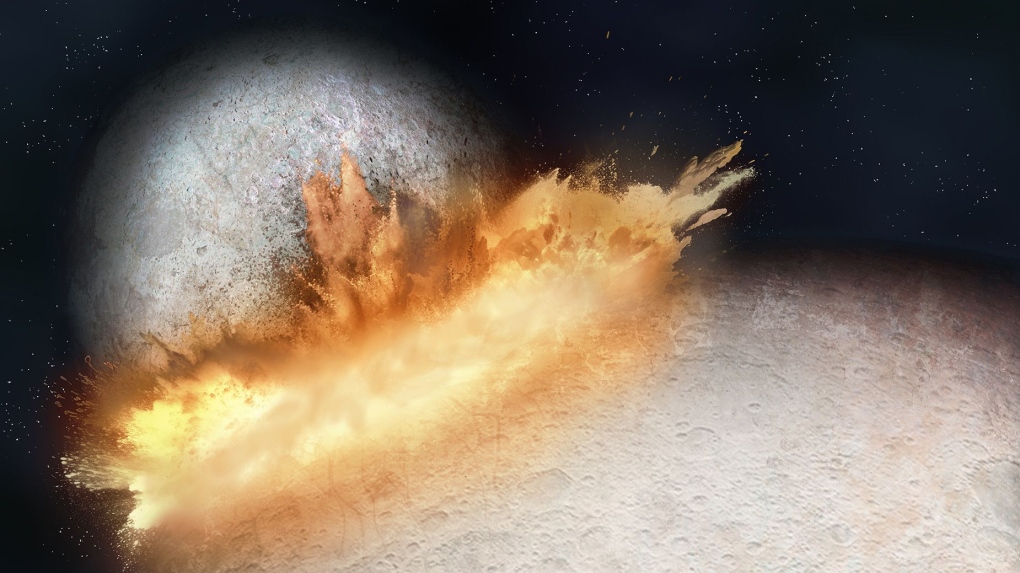A huge heart-shaped feature on the surface of Pluto has intrigued astronomers since NASA’s New Horizons spacecraft captured it in a 2015 image. Now, researchers think they have solved the mystery of how the distinctive heart came to be — and it could reveal new clues about the dwarf planet’s origins.
The feature is called Tombaugh Regio in honour of astronomer Clyde Tombaugh, who discovered Pluto in 1930. But the heart is not all one element, scientists say. And for decades, details on Tombaugh Regio’s elevation, geological composition and distinct shape, as well as its highly reflective surface that is a brighter white than the rest of Pluto, have defied explanation.
A deep basin called Sputnik Planitia, which makes up the “left lobe” of the heart, is home to much of Pluto’s nitrogen ice.
The basin covers an area spanning 745 miles by 1,242 miles (1,200 kilometres by 2,000 kilometres), equivalent to about one-quarter of the United States, but it’s also 1.9 to 2.5 miles (3 to 4 kilometres) lower in elevation than the majority of the planet’s surface. Meanwhile, the right side of the heart also has a layer of nitrogen ice, but it’s much thinner.
Through new research on Sputnik Planitia, an international team of scientists has determined that a cataclysmic event created the heart. After an analysis involving numerical simulations, the researchers concluded a planetary body about 435 miles (700 kilometres) in diameter, or roughly twice the size of Switzerland from east to west, likely collided with Pluto early in the dwarf planet’s history.
The findings are part of a study about Pluto and its internal structure published Monday in the journal Nature Astronomy.
Recreating an ancient ‘splat’ on Pluto
Previously, the team studied unusual features across the solar system, such as those on the far side of the moon, that were likely created by collisions during the early, chaotic days of the system’s formation.
The researchers created the numerical simulations using smoothed particle hydrodynamics software, considered the basis for a wide range of planetary collision studies, to model different scenarios for potential impacts, velocities, angles and compositions of the theorized planetary body’s collision with Pluto.
The results showed that the planetary body likely crashed into Pluto at a slanted angle, rather than head-on.
“Pluto’s core is so cold that the (rocky body that collided with the dwarf planet) remained very hard and did not melt despite the heat of the impact, and thanks to the angle of impact and the low velocity, the core of the impactor did not sink into Pluto’s core, but remained intact as a splat on it,” said lead study author Dr. Harry Ballantyne, research associate at the University of Bern in Switzerland, in a statement.
But what happened to the planetary body after it smacked into Pluto?
“Somewhere beneath Sputnik is the remnant core of another massive body, that Pluto never quite digested,” said study coauthor Erik Asphaug, professor at the University of Arizona’s Lunar and Planetary Laboratory, in a statement.
The teardrop shape of Sputnik Planitia is a result of the frigidity of Pluto’s core, as well as the relatively low velocity of the impact itself, the team found. Other types of faster and more direct impacts would have created a more symmetrical shape.
“We are used to thinking of planetary collisions as incredibly intense events where you can ignore the details except for things like energy, momentum and density. But in the distant Solar System, velocities are so much slower, and solid ice is strong, so you have to be much more precise in your calculations,” Asphaug said. “That’s where the fun starts.”
The New Horizons spacecraft took an image of Pluto’s heart on July 14, 2015. (Johns Hopkins University Applied Physics Laboratory/Southwest Research Institute/NASA via CNN Newsource)
Pluto’s murky origins
While studying the heart feature, the team also focused on the internal structure of Pluto. An impact early in Pluto’s history would have created a mass deficit, causing Sputnik Planitia to slowly migrate toward the dwarf planet’s north pole over time while the planet was still forming. This is due to the fact that the basin is less massive than its surroundings, according to the laws of physics, the researchers explained in the study.
However, Sputnik Planitia is near the dwarf planet’s equator.
Previous research has suggested that Pluto could have a subsurface ocean, and if so, the icy crust over the subsurface ocean would be thinner in the Sputnik Planitia region, creating a dense bulge of liquid water and causing a migration of mass toward the equator, the study authors said.
But the new study offers a different explanation for the feature’s location.
“In our simulations, all of Pluto’s primordial mantle is excavated by the impact, and as the impactor’s core material splats onto Pluto’s core, it creates a local mass excess that can explain the migration toward the equator without a subsurface ocean, or at most a very thin one,” said study coauthor Dr. Martin Jutzi, senior researcher of space research and planetary sciences at the University of Bern’s Physics Institute.
Kelsi Singer, a principal scientist at the Southwest Research Institute in Boulder, Colorado and co-deputy principal investigator on NASA’s New Horizons Mission, who was not involved with the study, said the authors did a thorough job of exploring the modeling and developing their hypotheses, though she would have liked to have seen “a closer tie to the geologic evidence.”
“For example, the authors suggest the southern portion of Sputnik Planitia is very deep, but much of the geologic evidence has been interpreted to point to the south being shallower than the north,” Singer said.
The researchers believe that the new theory regarding Pluto’s heart could shed more light on how the mysterious dwarf planet formed. Pluto’s origins have remained murky given that it exists on the edge of the solar system and has only been studied up close by the New Horizons mission.
“Pluto is a vast wonderland of unique and fascinating geology, so more creative hypotheses for explaining that geology are always helpful,” Singer said. “What would help to distinguish between different hypotheses is more information about the subsurface of Pluto. We can only get that by sending spacecraft mission to orbit Pluto, potentially with a radar that can peer through the ice.”




